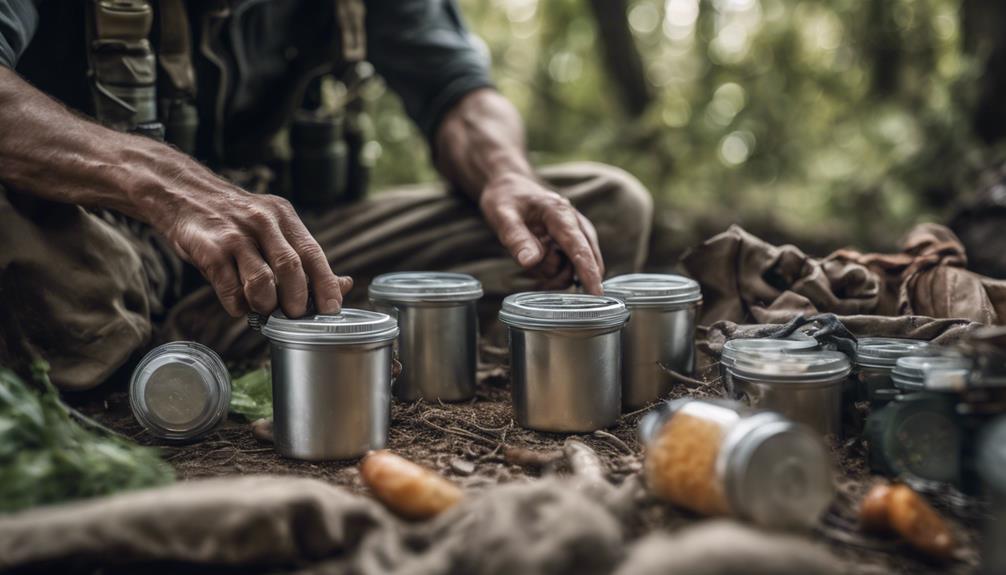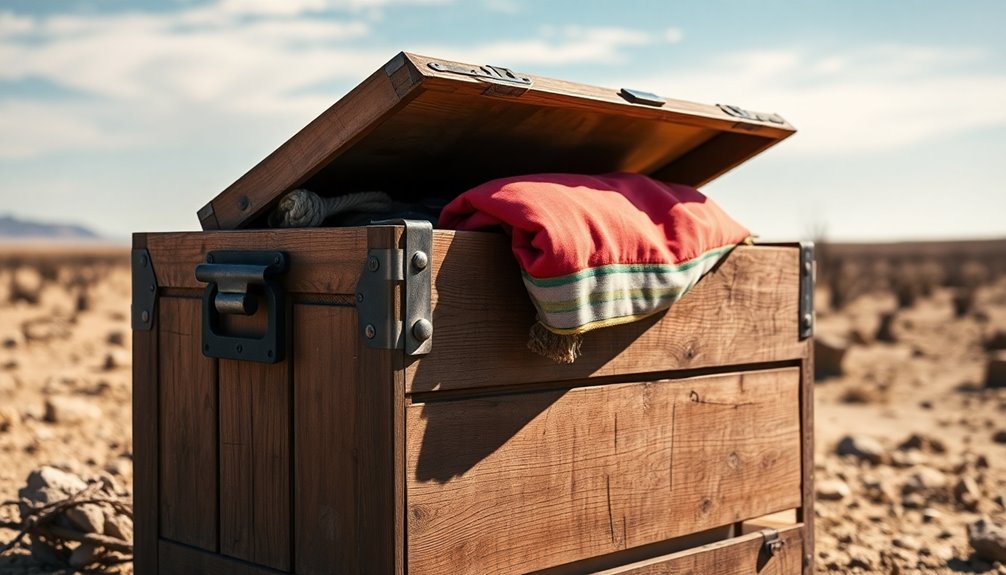Preppers often fall prey to survival myths. Playing dead is risky with predators, cold isn't the sole threat, and bottled water stockpiles can fail. Diversify water sources for safety, and learn purification methods. Forget climbing trees in danger. Secure spots or fight back against animals. Doorways aren't safest during earthquakes; follow Drop, Cover, Hold On. Underpasses are tornado traps; find sturdy shelter. Taping windows doesn't help in hurricanes; prep first aid and emergency plans. Discover more truths about survival myths to stay truly prepared. Local preppers and survivalists can help debunk false beliefs and spread accurate information on effective survival techniques. By connecting with these communities, you can exchange valuable tips and stay informed on the latest tools and strategies. Staying educated and adapting to real-world conditions is key to surviving unexpected emergencies.
Key Takeaways
- Playing dead doesn't always work in survival situations.
- Stockpiling only bottled water is flawed; diversify water sources.
- Cold weather isn't the sole threat to survival.
- Learning water purification techniques is essential for preppers.
- Beware of dangerous animal attack misconceptions in survival scenarios.
Common Prepper Survival Myths
When preparing for survival situations, it's vital to debunk common prepper survival myths to guarantee practical and effective readiness.
One prevalent myth revolves around playing dead to evade dangerous animals. While this might work in some specific scenarios, it isn't a foolproof method and can put you at risk in other situations.
Another misconception is that cold weather is the biggest threat in survival scenarios. While it's essential to prepare for low temperatures, other factors like dehydration and lack of food can be equally deadly.
Furthermore, the idea that stockpiling bottled water is the ultimate solution is flawed. Water is crucial, but relying solely on bottled water without knowing how to purify other water sources can lead to issues in the long run. It's important to diversify your water sources and learn purification techniques.
Dangerous Animal Attack Misconceptions

To navigate dangerous animal encounters effectively, it's important to debunk misconceptions surrounding animal attacks. When facing a potential threat, remember these essential points:
- Playing dead:
While playing dead may work for some animals, like possums, it can be risky with predators like bears. Some bears may not be deterred and could see you as a threat, leading to an attack.
- Running away:
Running from a predatory animal like a mountain lion can trigger their chase instinct, putting you at an increased risk of attack. Instead, try to back away slowly while maintaining eye contact.
- Making eye contact:
Direct eye contact with aggressive animals like wolves can be seen as a challenge, escalating the situation. It's best to avoid direct eye contact and slowly back away.
- Climbing trees:
Climbing trees to escape animal attacks may not be effective, as some predators are skilled climbers themselves. Instead, try to find a secure location or stand your ground and, if necessary, fight back with whatever means you have available.
Debunking Earthquake Survival Myths

When it comes to surviving earthquakes, it's vital to debunk some common myths for your safety.
Remember, standing in doorways is no longer the safest choice, as modern buildings are designed differently.
Embracing the Drop, Cover, and Hold On protocol is your best bet for protection during an earthquake.
Drop, Cover, Hold
During an earthquake, remember to drop to the ground, seek cover under a sturdy piece of furniture, and hold on until the shaking stops to protect yourself from potential harm.
Here's why this method is more effective than standing in doorways:
- Drop: By dropping to the ground, you reduce the risk of being knocked over by the shaking, preventing injuries from falls.
- Cover: Seeking shelter under a sturdy piece of furniture like a desk or table shields you from falling objects and debris that could cause harm.
- Hold on: Holding on to your sheltering furniture item keeps you protected and provides stability until the earthquake subsides.
- Safety: This internationally recognized protocol is designed to keep you safe from harm and is more reliable than outdated practices like standing in doorways.
Doorway Safety Myth
Contrary to popular belief, standing in doorways isn't a safe practice during earthquakes due to modern building standards. The doorway safety myth has been debunked by experts in earthquake safety. In the past, doorways were considered safer due to their sturdiness, but today's structures are more likely to collapse near doorways, posing a greater risk to individuals seeking refuge there.
The concept of the 'triangle of life,' which suggests safety next to objects like furniture, is controversial and generally not recommended by seismic safety professionals. Instead, the recommended earthquake safety action is to drop, cover, and hold on under a sturdy piece of furniture.
Doorways aren't necessarily stronger parts of buildings and may expose individuals to falling debris and collapsing structures during an earthquake.
To ensure your safety during an earthquake, seek shelter under furniture like tables or desks, as this practice has been proven to be more effective than standing in doorways.
Tornado Survival Myths Exposed

Dispelling the myth that hiding under overpasses is a safe tornado survival strategy. It's important to seek proper shelter during tornadoes to enhance your chances of survival.
Here are some essential facts to debunk common tornado survival myths:
- Flying Debris Danger: Hiding under overpasses exposes you to increased risk from flying debris and potential structural collapse.
- Swift Strikes: Tornadoes can strike suddenly, emphasizing the need to seek shelter in sturdy buildings or underground spaces promptly.
- Minimal Protection: Standing in doorways offers minimal protection; it's safer to move to an interior room away from windows.
- Glass Hazard: Taping windows before a tornado may create larger, more dangerous glass shards, making it safer to prioritize finding proper shelter.
Understanding these facts and having a designated safe area can greatly improve your chances of surviving a tornado. Stay informed and prepared to guarantee your safety during severe weather events.
Hurricane Survival Myths Busted

Don't fall for hurricane survival myths that could put your safety at risk. Taping windows won't protect them from breaking; instead, it can create larger, deadlier glass shards. Remember, hurricane winds can impact windows on all sides of a building, not just the ones facing water, so safeguard all windows.
Standing in doorways isn't a safe practice during hurricanes; doorways aren't structurally stronger than other parts of a building. Be cautious of the 'cone of uncertainty' in hurricane forecasting; it indicates potential paths, not a specific track, so prepare for various scenarios.
Insurance coverage may not fully replace all losses in a hurricane, emphasizing the need for a thorough emergency plan. Make sure you have a well-stocked first aid kit and a water filter to stay safe during hurricanes. Stay informed and prioritize your safety above all else.
Medical and General Survival Myths

Let's address some common misconceptions surrounding medical and general survival myths.
- Multivitamins: Contrary to popular belief, multivitamins may not provide significant health benefits.
- Dead bodies: Debunking a common myth, dead bodies don't spread diseases more than living individuals.
- Alcohol and warmth: Despite the misconception, alcohol doesn't actually warm the body.
- Fire starting: Starting a fire without practice can be challenging, emphasizing the importance of preparation.
When it comes to survival, it's important to separate fact from fiction. For instance, in a scenario like being stranded in a remote area in New York, knowing the truth about these myths can make a difference. Remember, when it comes to medical emergencies like injuries to the head and neck or situations where you need to feel warm, relying on accurate information and preparedness is key.
Frequently Asked Questions
What Percent of Americans Are Preppers?
About 3% of Americans are preppers who actively prepare for emergencies. Studies suggest around 80% believe in having emergency supplies, but not all prep. Factors like age and past experiences can influence prepping likelihood.
Why Is Prepping Pointless?
Hey, why is prepping pointless, you ask? Well, when prepping fixates on outlandish doomsday scenarios instead of practical emergencies, it can waste your time and resources. Focus on real threats for effective preparedness.
What Is the Difference Between a Prepper and a Survivalist?
You prepare for emergencies by stockpiling supplies and honing survival skills. Preppers focus on long-term readiness for societal collapse, relying on resources and fortified shelters. Survivalists prioritize immediate wilderness survival, using skills and adaptability.
What Is the Philosophy of Preppers?
The philosophy of preppers revolves around self-reliance, preparedness, and readiness for any crisis. They stockpile essentials, learn survival skills, and prioritize planning. Being self-sufficient and capable of surviving independently are key tenets of prepping.
Conclusion
To sum up, it's important to separate fact from fiction when it comes to survival myths. Remember, being prepared is key, but don't fall for common misconceptions that could actually put you in harm's way.
For example, many believe that drinking urine can help in a survival situation, but in reality, it can do more harm than good by dehydrating the body.
Stay informed, stay safe, and debunk those survival myths!










